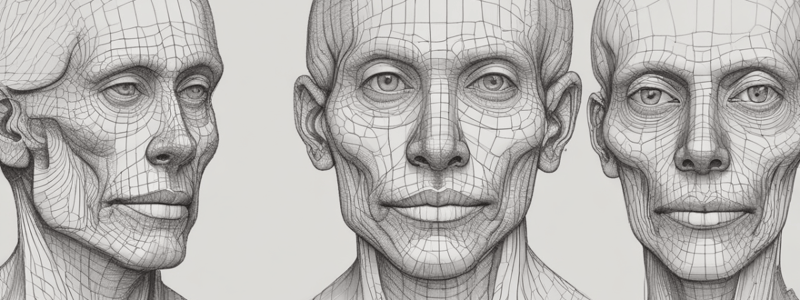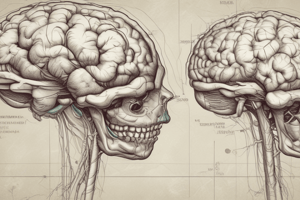Podcast
Questions and Answers
What is the superior border of the face?
What is the superior border of the face?
- The chin
- The nose
- The forehead (correct)
- The ears
What is the main function of the face?
What is the main function of the face?
- To protect the brain
- To facilitate speech
- To provide human identity and mediate interface (correct)
- To regulate body temperature
What is not a content of the face?
What is not a content of the face?
- Kidneys (correct)
- Salivary glands
- Musculature
- Facial bones
Why is the face subdivided into subregions?
Why is the face subdivided into subregions?
What nerve is responsible for cutaneous innervation of the face?
What nerve is responsible for cutaneous innervation of the face?
What is the purpose of defining the face as a discrete region?
What is the purpose of defining the face as a discrete region?
What does the facial skeleton comprise of?
What does the facial skeleton comprise of?
How many facial bones are there?
How many facial bones are there?
Which bone articulates with the temporal bone via the TMJ?
Which bone articulates with the temporal bone via the TMJ?
Where do the facial muscles originate from?
Where do the facial muscles originate from?
How many subgroups can the muscles of the face be classified into?
How many subgroups can the muscles of the face be classified into?
What is the action of the Orbicularis oculi muscle?
What is the action of the Orbicularis oculi muscle?
What is the origin of the Epicranius muscle?
What is the origin of the Epicranius muscle?
How many different facial muscles are there?
How many different facial muscles are there?
What is the characteristic of trigeminal neuralgia pain?
What is the characteristic of trigeminal neuralgia pain?
What is the origin of the orbicularis oculi muscle?
What is the origin of the orbicularis oculi muscle?
Which muscle is also known as the oral sphincter?
Which muscle is also known as the oral sphincter?
What is the most common cause of trigeminal neuralgia?
What is the most common cause of trigeminal neuralgia?
What is the primary function of the facial nerve?
What is the primary function of the facial nerve?
What is the function of the buccinator muscle?
What is the function of the buccinator muscle?
What is the role of the facial nerve in taste?
What is the role of the facial nerve in taste?
Which muscle originates from the zygomatic bone?
Which muscle originates from the zygomatic bone?
What is the role of the platysma muscle?
What is the role of the platysma muscle?
What is the treatment option for trigeminal neuralgia when drug treatment is ineffective?
What is the treatment option for trigeminal neuralgia when drug treatment is ineffective?
What is the gender ratio for trigeminal neuralgia?
What is the gender ratio for trigeminal neuralgia?
What is the main blood supplier to the face?
What is the main blood supplier to the face?
Which of the following arteries is NOT a branch of the external carotid artery?
Which of the following arteries is NOT a branch of the external carotid artery?
What is the pattern of venous drainage of the face?
What is the pattern of venous drainage of the face?
Which muscle is not primarily supplied by the facial nerve?
Which muscle is not primarily supplied by the facial nerve?
What is the function of the visceral motor component of the facial nerve?
What is the function of the visceral motor component of the facial nerve?
Which nerve is responsible for saliva production in the parotid gland?
Which nerve is responsible for saliva production in the parotid gland?
Where does the parotid duct open into the oral cavity?
Where does the parotid duct open into the oral cavity?
What is the primary function of the chorda tympani?
What is the primary function of the chorda tympani?
What is the location of the facial nerve as it travels towards the face?
What is the location of the facial nerve as it travels towards the face?
Which of the following is not a branch of the external carotid artery in the parotid gland?
Which of the following is not a branch of the external carotid artery in the parotid gland?
What is the purpose of defining the face as a separate anatomical region?
What is the purpose of defining the face as a separate anatomical region?
Flashcards are hidden until you start studying
Study Notes
The Facial Skeleton
- Facial bones belong to the viscerocranium, while the neurocranium encloses the brain.
- There are 14 facial bones:
- Inferior turbinal (2)
- Lacrimal (2)
- Maxilla (2)
- Mandible (1)
- Nasal (2)
- Palatine (2)
- Vomer (1)
- Zygomatic (2)
- Bones denoted with an asterisk (*) significantly shape the face, alongside the frontal bone; other soft tissues also contribute to facial features.
- The mandible uniquely articulates with the temporal bone through the temporomandibular joint (TMJ).
Muscles of the Face
- Facial muscles are superficial due to minimal tissue between the skin and skull; fat is more concentrated in the cheeks.
- Facial muscles originate on bones and insert onto skin, enabling facial expressions rather than limb movement.
- Muscles can be categorized into three groups:
- Muscles of the scalp, forehead, and eyebrows
- Muscles of the mouth, lips, and cheeks
- Muscles of the orbital opening
- There are approximately 17 main facial muscles, including:
- Epicranius: Raises eyebrows
- Orbicularis oculi: Closes and blinks eyes
- Orbicularis oris: Protrudes lips
- Buccinator: Flattens cheeks against teeth
- Zygomaticus: Raises mouth corners
- Platysma: Depresses mouth
The Face as a Discrete Region
- The face is defined by its anterior surface and bordered by the forehead, chin, and ears.
- For clinical purposes, the face is subdivided into regions to assist in diagnosing injuries or pathologies.
Contents and Role of the Face
- Contains facial bones, musculature, salivary glands, and sensory organs (eyes, nose, mouth).
- Functions include establishing human identity and providing muscles for facial expressions.
The Facial Nerve
- The facial nerve consists of motor, sensory, and parasympathetic components, with a significant role in taste.
- Primary motor functions include controlling facial expressions and movements around the mouth and eyes.
Motor Control of Facial Muscles
- Motor paths from the brain to facial muscles pass through foramina, facilitating muscle movement.
The Parotid Gland
- Enclosed in fascia, swelling can lead to pain (e.g., mumps).
- The facial nerve forms a plexus in the gland without innervating it; saliva production is regulated by the glossopharyngeal nerve.
- Parotid duct opens into the oral cavity adjacent to the upper second molar.
Trigeminal Neuralgia
- A rare condition causing unilateral facial pain, triggered by light touch, more common in females and older adults.
- Vascular compression is the primary cause in most cases; if untreated with medication, surgery may be considered, albeit at risk of complications.
Blood Supply and Venous Drainage
- The primary blood supply to the face comes from the external carotid artery, which branches into various arteries supplying facial structures.
- Facial veins generally parallel the arteries for drainage.
Studying That Suits You
Use AI to generate personalized quizzes and flashcards to suit your learning preferences.




